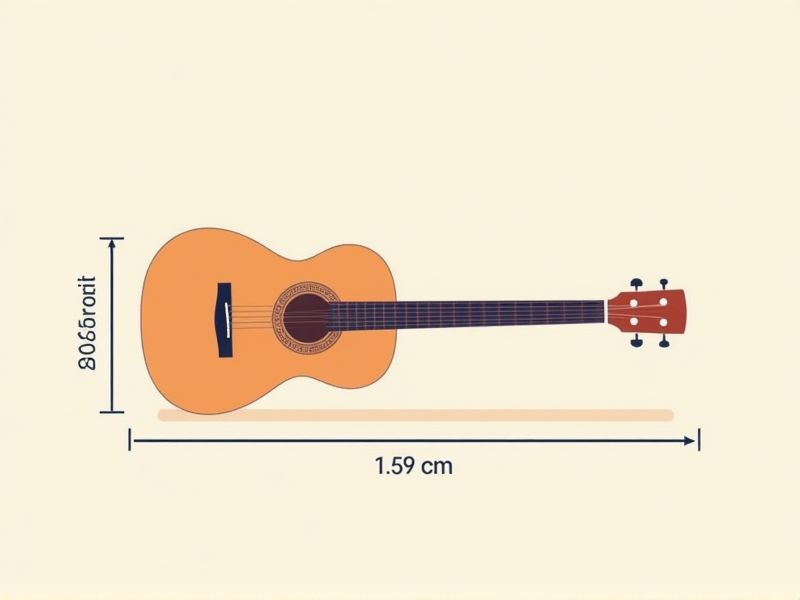
Guitars come in various shapes and sizes, but standard dimensions can help you choose the right fit. For most full-sized acoustic guitars, the total length is about 40 to 41 inches, with a scale length (the vibrating string length) of around 25.5 inches. The body width at the lower bout typically measures 15 to 16 inches, while the body depth is roughly 4 to 5 inches. Knowing these basic measurements can be useful when comparing different models or ensuring your guitar case will fit your instrument correctly.
Body Shape And Size
The standard guitar body shapes include dreadnought, concert, and parlor, each offering distinct tonal qualities and playability. Dreadnoughts, with their larger size, provide rich bass tones and volume, often favored by strummers and singer-songwriters. Concert guitars, slightly smaller, deliver brighter sounds and are ideal for fingerpicking styles, while parlor guitars, even more compact, are perfect for comfortable handling and intimate performances. When selecting a guitar, consider your playing style and the physical dimensions of the instrument, as the body size directly influences sound projection and overall comfort.
Scale Length
The scale length of a guitar, typically ranging from 24.75 to 25.5 inches, significantly influences tonal characteristics and playability. A shorter scale length often produces a warmer, mellower sound, making it ideal for jazz and blues genres. Conversely, a longer scale length delivers brighter tones and increased tension, preferred by rock and metal musicians for enhanced sustain and clarity. Understanding your desired musical style and comfort with string tension can help you choose the right scale length for your guitar.
Neck Width
The standard neck width of a guitar typically ranges from 1.450 inches (about 36.83 mm) for a narrow neck to 2.0 inches (approximately 50.8 mm) for wider models. A narrower neck is often preferred by players with smaller hands, allowing for easier fret access and faster playability. In contrast, a wider neck provides more space between strings, which can aid fingerstyle players and those who utilize complex chord shapes. When selecting a guitar, consider your playing style and hand size to determine the optimal neck width for your comfort and performance.
Nut Width
The nut width of a guitar is a critical measurement that significantly influences playability and tone. Typically ranging from 1.6 inches (40 mm) for narrower necks to 1.75 inches (44.5 mm) for wider options, the nut width affects the spacing between strings, which impacts finger placement and comfort during play. A wider nut width can enhance fingerstyle techniques, while a narrower nut may be preferred for faster picking and chord transitions. When choosing a guitar, consider your playing style and how nut width can enhance your overall musical experience.
Radius Of The Fingerboard
The fingerboard radius on a guitar significantly influences playability and comfort, impacting your overall playing experience. Standard radii often range from 7.25 inches to 16 inches, with 9.5 inches being a common choice for many Fender guitars. A smaller radius, like 7.25 inches, facilitates easier chord work and fret bends, while a flatter radius, such as 12 or 16 inches, enhances solo play and faster licks. Understanding the fingerboard radius helps you select the right guitar that aligns with your playing style and preferences.
Depth And Width Of The Body
The standard dimensions for a guitar's body typically emphasize a depth range of 3 to 4 inches and a width of 15 to 18 inches. These measurements significantly influence the instrument's tonal quality, with deeper bodies enhancing bass response and wider bodies promoting a balanced sound. Understanding these specifications can help you choose a guitar that best suits your playing style and musical preferences. Consider how the depth and width resonate with your desired sound before making a purchase.
Bridge Placement
The bridge placement on a guitar significantly influences the instrument's tonal qualities and playability. Most acoustic guitars feature the bridge located roughly at the 12th fret, ensuring optimal string tension and resonance. For electric guitars, the bridge can be positioned closer to the pickups, enhancing sustain and clarity when amplified. Precise placement can affect intonation as well, allowing you to achieve accurate tuning across the fretboard, which is crucial for your performance.
String Spacing
The standard string spacing for electric guitars typically ranges from 1.5 inches (38 mm) to 2 inches (51 mm) at the nut, while acoustic guitars often feature a wider spacing, ranging from 1.75 inches (44 mm) to 2.25 inches (57 mm). This spacing significantly influences playability, as wider string arrangements can facilitate fingerpicking techniques and enhance comfort for players with larger hands. For optimal performance, you should consider your playing style; if you favor strumming, a narrower spacing might be advantageous. Ultimately, understanding string spacing is crucial for selecting guitars that align with your personal preferences and technical requirements.
Fret Size And Number
Standard guitars typically feature fret sizes that range from medium to large, with a common number of 21 to 24 frets. The fret size affects playability, where larger frets can facilitate expressive bends and clearer notes. Most electric guitars employ 22 frets, allowing for extended playing range while maintaining comfort. If you're considering a guitar, keep in mind that the combination of fret size and number significantly impacts your musical experience.
Headstock Angle And Design
The angle of the headstock on a guitar typically ranges from 10 to 20 degrees, influencing both playability and tone. A tilted headstock can improve string tension, aiding in better tuning stability and sustain. The design, whether it's a solid or carved shape, can impact the instrument's weight distribution and aesthetic appeal. Various manufacturers often experiment with unique headstock designs, potentially enhancing the overall resonance and sonic character of the guitar.
